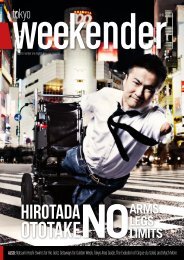Tokyo Weekender - October 2017
A day in the life of a geisha. Find your perfect Kyushu. Plus Q&A with anime director Keiichi Hara, are robots taking our jobs?, Explore Japanese cuisine at GINZA SIX, and Tsukuda guide
A day in the life of a geisha. Find your perfect Kyushu. Plus Q&A with anime director Keiichi Hara, are robots taking our jobs?, Explore Japanese cuisine at GINZA SIX, and Tsukuda guide
Create successful ePaper yourself
Turn your PDF publications into a flip-book with our unique Google optimized e-Paper software.
sic. Next to the bed you'll find a cute electronic<br />
creature called Churi-chan who can change<br />
the room temperature, turn on the lights and<br />
arrange a wake-up call, but only in Japanese.<br />
Other robots in the hotel include a foot-high<br />
concierge and a mechanical arm that will<br />
store your luggage. There are some humans<br />
working there because robots can't make<br />
beds or take care of security. They also aren't<br />
good at finding lost keys, so facial recognition<br />
technology is used instead. Earlier this year a<br />
second Henn-na Hotel was opened in Maihama,<br />
Chiba, near <strong>Tokyo</strong> Disney Resort.<br />
PAROLEE MENTORS<br />
While recidivism rates are relatively low in<br />
Japan, the number of repeat offenders among<br />
the elderly remains a real cause for concern.<br />
Many ex-cons are poor and lonely with no<br />
guarantors to check on them, so some might<br />
feel they'd be better off back inside where<br />
they'd be fed and surrounded by people.<br />
There aren't enough social workers to deter<br />
them from committing petty crimes, so last<br />
year the Ministry of Justice turned to Pepper,<br />
the four-foot robot that can analyze body<br />
language and read a person's emotions. It was<br />
placed in a <strong>Tokyo</strong> halfway house in the hope<br />
that former criminals would share things<br />
with the humanoid that they wouldn't with<br />
humans. It's more cost-effective than employing<br />
regular staff and robots can do 24-hour<br />
shifts without breaks. The problem is that the<br />
parolees are unlikely to ever fully develop an<br />
emotional attachment with the robot.<br />
CARE WORKERS AND COMPANIONS<br />
FOR THE ELDERLY<br />
Japan is experiencing population aging at a<br />
globally unprecedented pace. Around 26 percent<br />
of the nation's citizens are 65 or above,<br />
which is by far the highest proportion in the<br />
world, and by 2025 it's estimated that the<br />
country will face a shortage of around 380,000<br />
caregivers. An influx of foreign workers could<br />
help, but it's still unlikely to be enough. Carebots<br />
are, therefore, seen as a logical solution.<br />
They can provide physical therapy, assist with<br />
bathing, lifting and mobility, and monitor the<br />
whereabouts of the elderly through sensors.<br />
Communication is another particularly<br />
useful tool. Earlier this year a nursing home<br />
in Natori, Miyagi Prefecture began using a<br />
toddler-sized humanoid known as Telenoid<br />
that can capture the voice and movements of<br />
a loved one thousands of miles away using a<br />
microphone and camera. It then replicates<br />
those actions for the person in possession of<br />
the robot. Staff at the facility have noticed<br />
that elderly people, especially those with<br />
dementia, have become more positive and<br />
active when communicating with Telenoid.<br />
BUDDHIST MONKS<br />
Funerals in Japan certainly don't come<br />
cheap. There are all kinds of charges to<br />
factor in, including the price of a Buddhist<br />
priest whose services will usually<br />
cost around ¥240,000. Earlier this year<br />
plastic mold-making company Nissei Eco<br />
Ltd. attempted to create a much cheaper<br />
alternative by charging around ¥50,000 for<br />
Softbank's robot Pepper, which they programmed<br />
to chant sutras from four Buddhist<br />
sects in a computerized voice while tapping<br />
on a drum. It is reminiscent of the German<br />
robot BlessU-2, which can deliver blessings<br />
in five different languages and beams light<br />
from its hands. However, while BlessU-2 was<br />
designed to trigger debate about the future<br />
of the church and the potential of artificial<br />
intelligence, Pepper Priests have been introduced<br />
more as a matter of necessity. The<br />
traditional danka system, in which parishioners<br />
support temples through donations, is<br />
not as stable as it once was, so many monks<br />
are looking for part-time work away from<br />
their usual duties. Pepper is seen as a viable<br />
substitute while they are away, though many<br />
have questioned whether a robot can properly<br />
fulfil religious duties.<br />
THE ACTROID<br />
From Maria in Fritz Lang’s 1928 expressionist<br />
science-fiction drama Metropolis to<br />
C-3PO in Star Wars, robots have performed<br />
prominent roles in movies for decades. Yet,<br />
up to 2015 they have always either been<br />
played by humans or brought to life with<br />
motion capture technology. Things changed<br />
two years ago when Geminoid F co-starred<br />
in Koji Fukada’s flick Sayonara as Leona<br />
(pictured top right), becoming the first actor<br />
humanoid (called an “actroid”) to appear in<br />
a feature-length film. Equipped with motorized<br />
actuators enabling it to copy human expressions,<br />
the wheelchair-bound Leona stays<br />
loyal to its owner Tania, played by American<br />
actress Bryerly Long, following a lethal<br />
nuclear power plant meltdown in Japan. The<br />
robot is controlled by a computer owned<br />
by creator Hiroshi Ishiguro. The story was<br />
adapted from a play by Oriza Hirata, which<br />
also starred Geminoid F and Long. Other<br />
robots to have made a splash in the entertainment<br />
industry include Otonaroid (resembling<br />
a woman) and Kodomoroid (resembling a<br />
child), the world's first android newscasters,<br />
and DMM's Premaid AI robots that dance on<br />
table-tops like J-Pop stars.<br />
FOOT SNIFFERS<br />
Okay, so it's not what you would call a typical<br />
job, but Japan's latest innovative robot<br />
deserves a mention. Hana-chan, a play on<br />
the Japanese word for nose, is a cute robot<br />
dog equipped with an odor detection sensor<br />
for a nose. If your feet don't smell then<br />
Hana will wag its tail; it will bark if they are<br />
slightly malodorous; and if things are really<br />
bad it will keel over. The dog was created by<br />
manufacturers Next Technology, who were<br />
responding to a request from a man desperate<br />
to know if he had a smelly problem. Other<br />
scent-related tech that has recently gone on<br />
the market includes Panasonic's deodorizing<br />
coat hangers, which automatically eliminate<br />
odors and pollen from clothing, and a clip-on<br />
armpit fan devised by gadget maker Thanko.<br />
TOKYO WEEKENDER | OCTOBER <strong>2017</strong> | 27
















